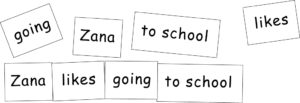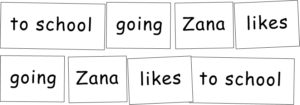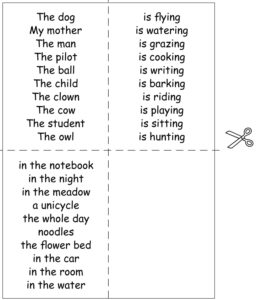Valuable opportunities for developing and teaching a feeling for sentence building and the syntactic repertoire are suggested in the exercises and experiments in #17.
The following exercises are particularly appropriate for younger students (1st –2nd grade) in that they promote the feeling for sentences and self-discovery of sentence construction. (The materials can be prepared by the teacher or older students):
- The instructor writes simple sentences on strips of paper and then cuts them up, not word for word, but by clauses. The paper pieces that belong together are held together with a paper clip. The students (alone or in pairs) receive one or more sets of the cut up sentences. Their task is to put them together to create functional sentences (and possibly write them down as well). Example:

Since, at times, there are various possibilities, they must absolutely be discussed (language feeling!). Example:

- Alone or in pairs, the students receive three lists of words: 1.) 10–12 nouns (subject), 2.) with 10–12 verbs, 3.) with 10–12 accusative objects and/or adverbs of place and time:For the “sentence computer“ use the cardboard (inner) core of a roll of toilet paper and wrap the paper strips, cut from an A4 size sheet of paper, around the core like a scroll. (see below).

The students move the three lists around to align the words and write down all the sentences which make sense. Variant: the lists are wrapped around a core (a round peg, or cardboard roll) to line up the words. The students then write down all the sentences which make sense. In moving the strips around the core to create different word combinations, students can generate meaningful and meaningless sentences with this “sentence computer“. 
- The above exercises can be expanded for older students by adding additional sentence elements (indirect object, adverbs of place and time, etc.).






